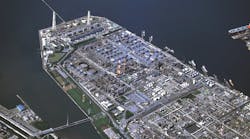Just as wireless gets signals and data from inaccessible places, hardware in the form of robots, drones, automated guided vehicles (AGV) and autonomous mobile robots (AMR) are following suit to monitor operations, and collect and relay data from hard-to-reach spots on plant-floors or in the field, where people don’t have the time or can’t go.
For example, Cosmo Oil Co. performance tested a quadruped robot from Boston Dynamics in September at its Yokkaichi refinery in central Japan. Cosmo is collaborating with Yokogawa Electric Corp. on this proof-of-concept (PoC) project in a temporarily closed facility at the refinery to determine how well robots can perform equipment and process inspections, and complete maintenance tasks (Figure 1).
“Cosmo refines crude oil into liquid propane (LP) gas, gasoline, jet fuel, diesel and other petroleum products. To ensure safety at our refineries, operators patrol these facilities to monitor the operating status of equipment and detect any anomalies at an early stage,” says Toshihiro Ito, manager of the project/IT system group in the refining and technology department at Cosmo. “With this initiative, we’re targeting the inspections carried out by operators, who walk around the plants to monitor the operating status of equipment and check for anomalies. We believe there’s room for automation in this area. Our desire to make operations more efficient at our refineries matched well with Yokogawa's interest in introducing the use of quadruped robots at such facilities.”
Wi-Fi for freedom
Users communicate with the robot via Wi-Fi, and it’s controlled by registering its walking routes. “We brought the quadruped robot to the refinery, and confirmed it was able to go up and down the stairs,” explains Ariyoshi Tada, associate senior corporate executive officer at Yokogawa Solution Service Corp. “We mainly checked the robot’s walking performance, and conducted the PoC test confirming its usefulness for maintenance activities.”
Cosmo and Yokogawa report they’re also identifying challenges for onsite applications, and selecting points that need to be verified to prepare for further onsite use of the robot. They also plan to accelerate adoption of other types of digitalization at refineries with an assist from robot-driven inspection and maintenance. As part of these digital transformation (DX) efforts, Cosmo held workshops in November at its Chiba refinery near Tokyo on how to use these and other digitalized tools like artificial intelligence (AI) to improve refinery operations. Cosmo and Yokogawa add that robots, drones and digital devices will help achieve “refineries where humans, robots and AI can work together,” starting at Cosmo’s Yokkaichi, Chiba and Sakai facilities.
“While I can’t go into specifics, the results of the PoC test were impressive. We can see the potential for using quadruped robots in plants,” adds Ito. “At the same time, we identified issues that will need to be resolved, and will accelerate our efforts to investigate these points. There are many challenges with using latest technologies that can only be uncovered by conducting PoC tests, so it’s important to take that first step.”





